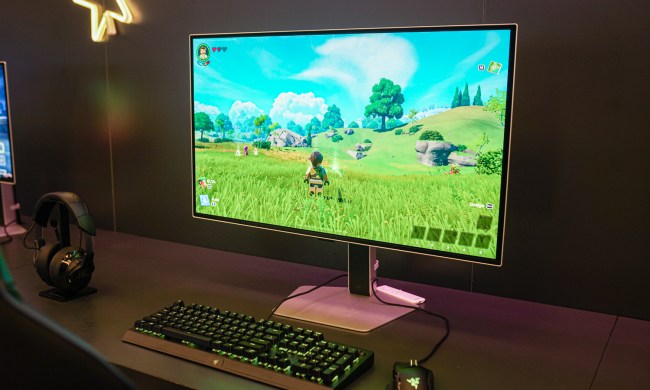LG has just announced the upcoming release of three exciting new monitors, including a real treat for those who like to game on a large screen: A 48-inch OLED gaming monitor.
Aside from LG’s first OLED display made for gamers, there are also 4K Nano IPS and QHD Nano IPS monitors to choose from.

LG’s new UltraGear lineup includes the following models: 32GQ950, 32GQ850, and 48GQ900. As you can see, two of them sport a 32-inch screen, while one is an enormous 48-inch beast. Perhaps more importantly, it’s a first for LG, because it’s the brand’s first UltraGear OLED gaming monitor.
All three of the monitors share a similar aesthetic that brings e-sports to mind with its sharp angles. The bezels are fairly thin, although the two 32-inchers have a considerably wider bottom bezel. Another thing they all have in common is that they all offer access to HDMI 2.1 connectivity, and by extension, features such as a variable refresh rate (VRR) as well as 4K gaming.
Each of the new LG UltraGears is compatible with Nvidia G-Sync and AMD FreeSync Premium, but the 32-inch models support FreeSync Premium Pro. In addition, each of the monitors has a headphone jack with support for surround sound DTS Headphone:X, so you can plug in a headset as you game. However, most people will still prefer to simply plug the headphones directly into the PC or console.
Let’s start with the most impressive entry of this lineup, and that, undoubtedly, is the 48GQ900 — a 48-inch 4K gaming monitor with an OLED panel as well as 120Hz refresh rates and a 0.1ms response time. The 120Hz refresh rate can be brought up to 138Hz by overclocking.
Being an OLED monitor, the screen has the potential to deliver beautiful colors and deep contrasts. LG tops it off with an anti-glare low reflection coating. If you want a large-scale immersive gaming experience, it sounds like this UltraGear screen could be the choice for you, but LG hasn’t revealed its price yet. One thing is almost certain — it won’t come cheap.

Moving on to the two 32-inch (or more precisely, 31.5-inch) monitors, they share the same size and panel type: Nano IPS, as well as the same 1ms response time. Unlike the larger model, they have more flexible stands, which means they can pivot and they are tilt as well as height adjustable.
The UltraGear 32GQ950 gives you access to 4K gaming with its 3,840 x 2,160 resolution. It’s also LG’s first model to implement ATW Polarizer technology. LG teases that using this tech will ensure stunning colors, deep blacks, and strong contrasts, all across a wide viewing angle. The monitor is VESA Display HDR 1000 certified, meaning its brightness peaks at 1,000 nits. The refresh rate is slightly higher than on the 48-inch model, bringing 144Hz that can be overclocked up to 160Hz.
Lastly, we have the 32GQ850, and although it has a few things in common with its sibling, you’ll also note a few key changes. This is a QHD monitor with a 2,560 x 1,440 resolution that brings the refresh rates up by a considerable amount, peaking at 260Hz when overclocked. The brightness is toned down from the other 32-inch screen, seeing as this one is VESA DisplayHDR 600 certified.
LG hasn’t talked about the pricing yet, but it has announced an approximate release date. The monitors will first hit the market in Japan starting this month. Markets in North America, Europe, and Asia are to follow at an undetermined time, but it probably won’t be too long before they start climbing the rankings of the best gaming monitors.



